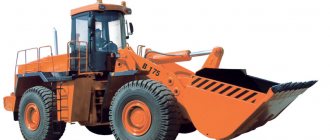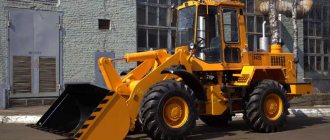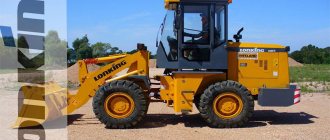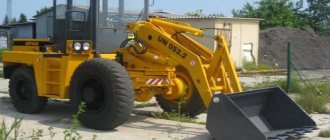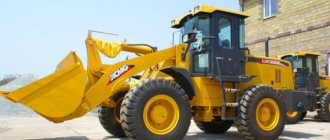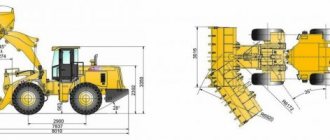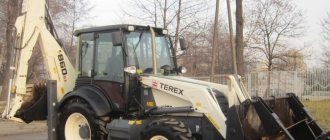When constructing objects for various purposes, special-purpose self-propelled equipment is used. When transporting goods and storing materials, loading and digging, or towing equipment, it is impossible to do without mobile equipment.
A front loader is a vehicle equipped with a device for picking up and moving objects, performing quarry work and towing bulk or piece materials within a construction site. The working mechanism of the loader is a boom with an operating device. Some models are equipped with a specially designed boom, the fastening mechanisms of which can be equipped with hooks, forks, irons for clearing snow from the road, grips, and buckets of various sizes.
The front loader is equipped with hydraulic cylinders, thanks to which the technical unit has the ability to rotate the working element 180° in relation to the boom, rods and rocker arm. During operation, the hydraulic system compensates for the load with technical oil pressure, which makes it possible to determine the mass of the load captured by the bucket.
Loader with weighing terminal
A front-end loader is an indispensable assistant at a construction site. Special equipment with a weighing terminal is especially popular. By connecting the hydraulic cylinder to the pressure sensors, the signal is converted into digital readings and displayed on the display. Working on a front loader with a weighing terminal allows you to monitor the amount of material loaded into the mixing drum or onto the vehicle. The weight of each portion of the product is summed up with previous indicators, and the digital value of the total weight is displayed on the monitor.
Despite the fact that a front-end loader at a construction site experiences heavy mechanical and vibration loads, load sensors are not affected by them. The weighing system, which can be installed on any model of special equipment, is powered from the machine’s electrical network.
Front loader application
Thanks to such technical advantages as mobility, maneuverability, endurance, and the ability to operate in confined spaces, front loaders can be used in the following areas:
- In the construction industry. The technique is very popular in both civil and industrial construction. With the help of self-propelled, functional loaders, supplemented with attachments (jaw gripper, grader bucket, mounting hook, multi-jaw bucket, etc.), you can successfully transport construction materials, load products into the body, unload, and store. Direct load and side loader models are available. The maneuverability and endurance of the equipment allows you to quickly and efficiently solve the most complex problems;
- In warehouse logistics. The purpose of forklifts is to perform loading and unloading operations, moving, storing, stacking piece and palletized cargo, and working with bulk and small-piece materials. Warehouse equipment is used to work with food, medical products, household chemicals, construction materials, equipment and spare parts, etc. For warehouse work in small enclosed spaces, electric forklifts are the best option. Models with a diesel engine are recommended for use in large areas (stations, airport terminals, parking lots, seaports and docks, etc.);
- In the housing and communal services sector. Compact and multifunctional front loaders can be equipped with blades, buckets, and other attachments designed for removing snow and debris, leveling areas, digging trenches, etc.;
- In the agricultural sector. The ability to equip equipment with functional attachments allows you to effectively perform operations related to loading/unloading, moving cargo (snow, silage, bulk products, in bags, barrels, etc.).
Loaders are used in metallurgy, energy and mining industries, oil and gas industries and mechanical engineering. An important feature of the machines is the ability to quickly adapt to specific operating conditions, endurance and durability.
Loader control
Operating a front loader does not require special training. The driver is provided with a modern control system with prompts. Depending on the design features, the control elements can be located on the panel or on the armrests.
The following controls are used:
- levers;
- mini levers;
- buttons;
- keys;
- joysticks.
The front loader operator works in comfortable conditions; the workplace is located in a cabin, glazed on all sides. Its space provides freedom of action, the shock absorption system reduces vibration levels, and high-quality insulation reduces noise levels. Modern models of construction equipment are equipped with air conditioning and a dust removal system.
Types and design features of loaders
Basically, front loaders are divided into two types: wheeled and tracked. In off-road conditions and on soft ground, it is more advisable to use tracked vehicles, while wheeled vehicles are most often used on hard-surfaced areas. Pneumatic vehicles can move on public asphalt roads, as a rule, have less weight and relatively low fuel consumption. Based on size and load capacity, front loaders are divided into large, medium, small and mini.
The power units of the machines are internal combustion engines running on diesel fuel or gasoline. There are modifications equipped with electric motors, thanks to which they can be used in closed warehouses and production facilities. On most models, the engine is located behind the operator's cab and drives both the machine's transmission and hydraulic equipment.
The modern design of a front-end loader involves the location of all components and assemblies on an articulated frame, which consists of two half-frames connected by hinges. A hydraulic drive at the articulation point controls the position of both the front and rear axles. This design scheme provides higher maneuverability of the loader compared to all-frame machines. In addition, operating efficiency and the most ergonomic distribution of loads along the axes are significantly increased. As for the main working element - the boom, thanks to the attachment of its arms to the front part of the frame, the maximum lifting height of the bucket and a significant reach of the boom are ensured. Hydraulics are responsible for controlling the boom mechanisms. The loading module can have a Z-shaped or H-shaped device layout.
The operating principle of the front loader hydraulic system is simple and clear. The system consists of a pump and a liquid tank, which are connected through conductive lines. Oil from the hydraulic tank is supplied to the distribution valve, and from there to the corresponding cylinder. Thanks to the pressure created in the system, the working mechanisms of the loader are set in motion, the boom extension and the angle of inclination of the bucket are adjusted.
The operator's cabin of a modern loader is a comfortable workplace where all controls are concentrated. Thanks to the high position and panoramic glazing, maximum visibility is achieved when moving on the road and when performing work. The cabin is equipped with a heating and air conditioning system and is well protected from noise and vibration, as well as from accidental drops of cargo.
On modern models, a multifunctional joystick is used as the main control, with which the operator performs the necessary manipulations without exerting physical effort.
Specifications
A modern front-end loader, the characteristics of which depend on its design features, is capable of performing a large amount of work in one work shift. As standard, the vehicle weight is 8.4 tons, with an engine power of 120 hp, the speed of the machine on standard tires reaches 20-35 km/h.
With a maximum pressure in the hydraulic system of 279 bar, the pump capacity is 140 liters per minute. The machine's bucket can accommodate a load weighing up to 3500 kg, the tipping load with the bucket is 5.4 tons. The digging depth of the bucket reaches 0.2 m, the tipping angle at maximum height is 52-55°, the grip angle at ground level does not exceed 47° . The bucket lifting time takes 3.9-6.2 seconds. Unloading by tipping occurs in 1.7-2.2 seconds.
Features and Benefits
The main advantages of the machine include comfort, safety, ease of maintenance, and versatility. Other advantages of the JCB 426 front loader include:
- use of units and mechanisms from global manufacturers, including Bosch, ZF, Parker;
- the ability to maintain technical characteristics when working in difficult conditions - at elevated temperatures, humidity, dust;
- the ability to install various attachments;
- high torque at low engine speed;
- productivity and efficiency;
- long term trouble-free operation;
- extended service intervals.
An optional leveling system is installed, which prevents materials from spilling out of the bucket in large quantities. It reduces vibrations of the working body, compensates for dynamic loads, and reduces cycle time.
Return to navigation
Mining
The front loader in quarries, mines and the mining industry is the main part of the special equipment fleet. There they are maximally loaded and sometimes around the clock. For mining, front-end loaders with a lifting capacity of over 5 tons are most often used, with components that have a longer service life before major repairs of the internal combustion engine and gearbox.
Operator's cabin
In addition to high technical characteristics, the JCB 426 has a comfortable cabin. It offers a 360-degree view, and the improved hood shape allows you to see the work site. Cabin features include:
- rear view cameras (optional);
- air conditioning (optional);
- heated seat with air suspension (optional);
- Conducting daily inspections from ground level;
- ease of access to the cabin due to comfortable steps with anti-slip coating and handrails;
View from the operator's cabin
- creating a comfortable temperature in the cabin through ventilation, heating and air conditioning systems;
- the ability to select the purity of air purification and the speed of its supply to the cabin;
- tightness of the JCB 426ZX loader interior;
- ease of filter replacement;
- spacious storage compartments;
- large cabin volume – 3 m3;
- easy-to-use controls;
- ergonomic seat with high back.
Return to navigation
Device
The rear part of the machine is made of steel by casting. For many analogues, this element is made of plastic and is therefore short-lived. A steel bumper guarantees protection from damage and reduces equipment maintenance costs. The sloping hood at the rear of the JCB 426 provides good visibility, which has a positive effect on safety. The bottom is made of a single sheet, which protects the transmission components from serious damage.
Loading materials and moving them from place to place occurs with maximum comfort if you activate the Smoothride boom smoothing system. With it, productivity and operating parameters will be very high. This also has a positive effect on the speed of movement, because dynamic vibrations are not transmitted to the loader and load.
Return to navigation
Ease of operation and maintenance
Special equipment is characterized by ease of maintenance work. This is due to easy access to main service points, most often from ground level. The units are arranged modularly, which reduces downtime and allows the machine to quickly pay for itself. The cooling system and engine bay are located behind the swing-out fan and one-piece hood.
Service intervals are 500 machine hours.
Return to navigation
Hydraulic system
The JCB 426 ZX front loader is equipped with a transmission shut-off feature, which improves hydraulic system performance and limits travel speed when loading. The hydraulic system has a unique feature - power is consumed only when it is necessary to increase work productivity to the maximum.
Hydraulic replaceable carriages are installed as standard. Hydraulic hoses are resistant to ultraviolet radiation and technical fluids. The hydraulic system pumps 210 liters of oil.
Return to navigation
Attachments
Bucket SDLG LG936L
The working elements are designed in such a way that the maximum breakout force is created at the edge of the bucket. The working body of the standard assembly holds 1.8 cubic meters. m of materials. It is also possible to replace working parts in order to increase the efficiency of the equipment. You can buy the SDLG LG936L loader complete with buckets of various capacities, different types of teeth, modified configurations, etc. There are also buckets designed for working with rocky soils with a capacity of 1.5 cubic meters. m and light rocks with a capacity of 2.5 cubic meters. m, 4-in-1 type buckets with side discharge.
Other types of attachments include forks, jaws, blades, etc. It is also possible to install other types of working bodies.
Return to navigation
Engine
The loader is equipped with a six-cylinder Cummins QSB diesel engine with a volume of 6.7 liters. It is equipped with air cooling systems, direct fuel supply with electrical control and exhaust filters, which allows the latter to comply with Tier 2 requirements. The JCB 426ZX has a power of 123 kW and a torque of 732 Nm.
The second equipment option is the American 8TAA5.9C engine, equipped with a turbocharger. It is characterized by an output of 113 kW or 152 horsepower. In terms of exhaust quality and noise level, it fully complies with European and American requirements.
The fuel tank can hold 230 liters of diesel.
Return to navigation
Areas of application for forklifts
In the field of cargo transportation, forklifts are most often used, which are now considered a must-have equipment for efficient warehouse logistics management. Forklifts transport goods in the warehouses of a transport company.
The functionality of this type of equipment is expanded through the use of forks. Using these devices, you can stack pallets or any other types of transport containers used in the warehouse. Due to the fact that it is possible to modify this type of special equipment, the forklift has gained such popularity in the field of cargo transportation.
